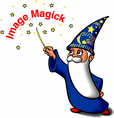


| animate - animate a sequence of images |
|
animate [ options ...] file [ [
options ...] file ...]
|
|
Animate displays a sequence of images on any workstation display running an X server. animate first determines the hardware capabilities of the workstation. If the number of unique colors in an image is less than or equal to the number the workstation can support, the image is displayed in an X window. Otherwise the number of colors in the image is first reduced to match the color resolution of the workstation before it is displayed. This means that a continuous-tone 24 bits-per-pixel image can display on a 8 bit pseudo-color device or monochrome device. In most instances the reduced color image closely resembles the original. Alternatively, a monochrome or pseudo-color image sequence can display on a continuous-tone 24 bits-per-pixel device. To help prevent color flashing on X server visuals that have colormaps, animate creates a single colormap from the image sequence. This can be rather time consuming. You can speed this operation up by reducing the colors in the image before you "animate" them. Use mogrify to color reduce the images to a single colormap. See mogrify(1) for details. Alternatively, you can use a Standard Colormap; or a static, direct, or true color visual. You can define a Standard Colormap with xstdcmap. See xstdcmap(1) for details. This method is recommended for colormapped X server because it eliminates the need to compute a global colormap. |
|
To animate a set of images of a cockatoo, use:
animate cockatoo.*
To animate a cockatoo image sequence while using the Standard Colormap
best, use:
xstdcmap -best
animate -map best cockatoo.*
To animate an image of a cockatoo without a border centered on a backdrop,
use:
animate +borderwidth -backdrop cockatoo.*
|
|
For a more detailed description of each option, see
ImageMagick(1).
For a more detailed description of each option, see
ImageMagick(1).
Any option you specify on the command line remains in effect for the group
of images following it, until the group is terminated by the appearance of
any option or -noop. For example, to animate three images, the first
with 32 colors, the second with an unlimited number of colors, and the
third with only 16 colors, use:
animate -colors 32 cockatoo.1 -noop cockatoo.2 -colors 16 cockatoo.3
Animate options can appear on the command line or in your X resources file. See X(1). Options on the command line supersede values specified in your X resources file. Image filenames may appear in any order on the command line if the image format is MIFF (refer to miff(5) and the scene keyword is specified in the image. Otherwise the images will display in the order they appear on the command line. |
|
Press any button to map or unmap the Command widget. See the next section for more information about the Command widget. |
|
The Command widget lists a number of sub-menus and commands. They are
Menu items with a indented triangle have a sub-menu. They are represented above as the indented items. To access a sub-menu item, move the pointer to the appropriate menu and press a button and drag. When you find the desired sub-menu item, release the button and the command is executed. Move the pointer away from the sub-menu if you decide not to execute a particular command. |
|
|
Animate options can appear on the command line or in your X resource file. Options on the command line supersede values specified in your X resource file. See X(1) for more information on X resources. All animate options have a corresponding X resource. In addition, the animate program uses the following X resources:
|
|
|
|
John Cristy,
magick-users@imagemagick.org,
ImageMagick Studio LLC, |
|
Copyright (C) 2003 ImageMagick Studio Permission is hereby granted, free of charge, to any person obtaining a copy of this software and associated documentation files ("ImageMagick"), to deal in ImageMagick without restriction, including without limitation the rights to use, copy, modify, merge, publish, distribute, sublicense, and/or sell copies of ImageMagick, and to permit persons to whom the ImageMagick is furnished to do so, subject to the following conditions: The above copyright notice and this permission notice shall be included in all copies or substantial portions of ImageMagick. The software is provided "as is", without warranty of any kind, express or implied, including but not limited to the warranties of merchantability, fitness for a particular purpose and noninfringement.In no event shall ImageMagick Studio be liable for any claim, damages or other liability, whether in an action of contract, tort or otherwise, arising from, out of or in connection with ImageMagick or the use or other dealings in ImageMagick. Except as contained in this notice, the name of the ImageMagick Studio LLC shall not be used in advertising or otherwise to promote the sale, use or other dealings in ImageMagick without prior written authorization from the ImageMagick Studio. |